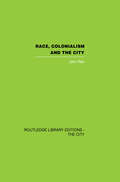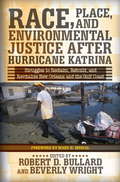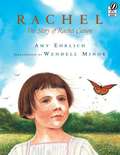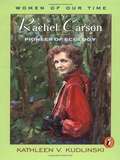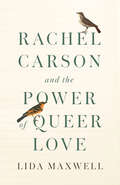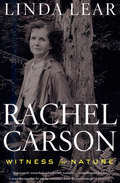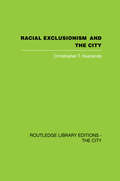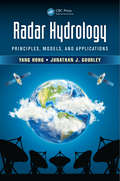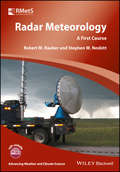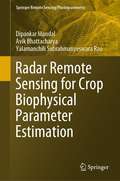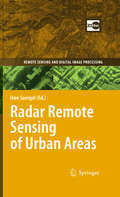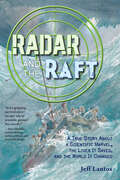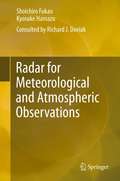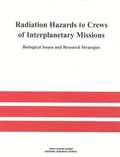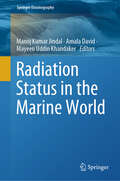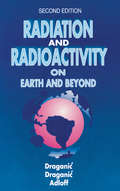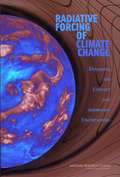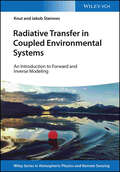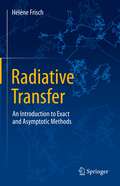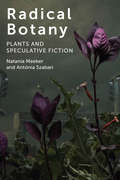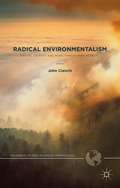- Table View
- List View
Race and Racism: Essays in Social Geography
by Peter JacksonFirst Published in 1987. Routledge is an imprint of Taylor & Francis, an informa company.
Race, Colonialism and the City
by John RexJohn Rex is well known as one of Britain's leading sociologists and for his special interest in the sociology of race relations and the sociology of the city. In the present book these two related areas are brought together. Professor Rex discusses imperialistic social systems, and examines the position of black people at the colonial and metropolitan ends of thoses systems. This book was first published in 1973.
Race, Place, and Environmental Justice After Hurricane Katrina
by Robert BullardAnalyzing the immediate and long-term repercussions of Hurricane Katrina, the essays in this volume expose the racial disparities that exist in disaster response and recovery and challenge the geography of vulnerability
Rachel
by Amy EhrlichRachel Carson was always curious about the world around her. As a girl, she loved being outside, exploring and learning more about the universe. As an adult, Rachel wrote books, including Silent Spring, considered to be the start of today's environmental movement. An epilogue highlights on Rachel Carson's work and life.
Rachel Carson
by Kathleen V. KudlinskiRachel Carson--scientist, author, and environmentalist Rachel Carson was always fascinated by the ocean. As a child, she dreamed of it and longed to see it. As a young woman, she felt torn between her love for nature and her desire to pursue a writing career. Then she found a way to combine both. Rachel had a talent for writing and talking about science in a way that everyone could understand and enjoy. With her controversial book, Silent Spring, Rachel Carson changed the way we look at our planet. "Kudlinski has admirably captured the driving force of spirit of a shy but courageous woman in a succinct, respectful approach."--Booklist About the Women of Our Time series: International in scope, the Women of Our Time series of biographies cover a wide range of personalities in a variety fields. More than a history lesson, these books offer carefully documented life stories that will inform, inspire, and engage.
Rachel Carson Preserving a Sense of Wonder: Preserving A Sense Of Wonder (Images Of Conservationists Ser.)
by Joseph Bruchac Thomas LockerA biography of Rachel Carson interspersed with her own memorable quotes.
Rachel Carson and Ecology for Kids: Her Life and Ideas, with 21 Activities and Experiments (For Kids series)
by Rowena RaeRachel Carson was an American biologist, conservationist, science and nature writer, and catalyst of the modern environmental movement. She studied biology in college at a time when few women entered the sciences, and then worked as a biologist and information specialist for the US government and wrote about the natural world for many publications. Carson is best remembered for her book Silent Spring, which exposed the widespread misuse of chemical pesticides in the United States and sparked both praise and fury. Carson's personal life and scientific career were rooted in the study of nature. Using examples from Carson's life and works, Rachel Carson and Ecology for Kids will introduce readers to ecology concepts such as the components of ecosystems, adaptations by living things, energy cycles, food chains and food webs, and the balance of ecosystems. This lively biography includes a time line, resources, sidebars, and 21 hands-on activities that are sure to inspire the next generation of scientists, thinkers, leaders, agricultural producers, environmental activists, and world citizens. Kids will:Collect a seed bank of local plant speciesChart bird migration through their regionMake birdseed cookiesModel bioaccumulation and biomagnificationBuild a worm farmAnd more!
Rachel Carson and the Power of Queer Love
by Lida MaxwellHow Silent Spring stands as a monument to a unique, loving relationship between Rachel Carson and Dorothy Freeman, and how such love underpins a new environmental politics After the success of her first bestseller, The Sea Around Us, Rachel Carson settled in Southport, Maine. The married couple Dorothy and Stanley Freeman had a cottage nearby, and the trio quickly became friends. Their extensive and evocative correspondence shows that Dorothy and Rachel did something more: they fell in love. In this moving new book, Lida Maxwell explores their letters to reveal how Carson's masterpiece, Silent Spring, grew from the love these women shared for their wild surroundings and, vitally and increasingly, for each other. Carson had already demonstrated a profound environmental awareness by the time she purchased her home in Maine; Maxwell proposes that it took her love for Dorothy to open up a more powerful space for critique. As their love unsettled their heteronormative ideas of bourgeois life, it enabled Carson to develop an increasingly critical view of capitalism and its effects on nonhuman nature and human lives alike, and it was this evolution that made the advocacy of Silent Spring possible. In Rachel Carson and the Power of Queer Love, Silent Spring's exposé of the dangerous and loveless exhaustion of nature for capitalism's ends is set in bold relief against the lovers' correspondence, in which we see the path toward a more loving use of nature and a transformative political desire that, Maxwell argues, should inform our approach to contemporary environmental crises.
Rachel Carson: Witness for Nature
by Linda LearThe authoritative biography of the marine biologist and nature writer whose book Silent Spring inspired the global environmentalist movement. In a career that spanned from civil service to unlikely literary celebrity, Rachel Carson became one of the world&’s seminal leaders in conservation. The 1962 publication of her book Silent Spring was a watershed event that led to the banning of DDT and launched the modern environmental movement. Growing up in poverty on a tiny Allegheny River farm, Carson attended the Pennsylvania College for Women on a scholarship. There, she studied science and writing before taking a job with the newly emerging Fish and Wildlife Service. In this definitive biography, Linda Lear traces the evolution of Carson&’s private, professional, and public lives, from the origins of her dedication to natural science to her invaluable service as a brilliant, if reluctant, reformer. Drawing on unprecedented access to sources and interviews, Lear masterfully explores the roots of Carson&’s powerful connection to the natural world, crafting a &“fine portrait of the environmentalist as a human being&” (Smithsonian). &“Impressively researched and eminently readable . . . Compelling, not just for Carson devotees but for anyone concerned about the environment.&” —People &“[A] combination of meticulous scholarship and thoughtful, often poignant, writing.&” —Science &“A sweeping, analytic, first-class biography of Rachel Carson.&” —Kirkus Reviews
Racial Exclusionism and the City: The Urban Support of the National Front
by Christopher T. HusbandsFirst published in 1983, this book reports on the results of a survey in thirteen areas of England where the National Front (NF) had previously gained significant levels of electoral support and examines the social and political histories of these areas to reveal not only who and was voting for the NF in the 1970s but also why.
Radar Hydrology: Principles, Models, and Applications
by Yang Hong Jonathan J. GourleyRadar Hydrology: Principles, Models, and Applications provides graduate students, operational forecasters, and researchers with a theoretical framework and practical knowledge of radar precipitation estimation. The only text on the market solely devoted to radar hydrology, this comprehensive reference: Begins with a brief introduction to radar Focuses on the processing of radar data to arrive at accurate estimates of rainfall Addresses advanced radar sensing principles and applications Covers radar technologies for observing each component of the hydrologic cycle Examines state-of-the-art hydrologic models and their inputs, parameters, state variables, calibration procedures, and outputs Discusses contemporary approaches in data assimilation Concludes with methods, case studies, and prediction system design Includes downloadable MATLAB® content Flooding is the #1 weather-related natural disaster worldwide. Radar Hydrology: Principles, Models, and Applications aids in understanding the physical systems and detection tools, as well as designing prediction systems.
Radar Meteorology: A First Course (Advancing Weather and Climate Science)
by Robert M. Rauber Stephen W. NesbittA comprehensive introduction to the current technology and application of radar in meteorology and atmospheric sciences Written by leading experts in the field, Radar Meteorology, A first Course offers an introduction to meteorological radar systems and applications, with emphasis on observation and interpretation of physical processes in clouds and weather systems. This comprehensive introduction to the subject offers an overview of the quantities essential to radar meteorology including the radar reflectivity factor, and Doppler, dual-polarization, and multi-wavelength radar variables. The authors highlight wind retrieval from single and multiple Doppler radars, precipitation estimation and hydrometeorological applications, with chapters dedicated to interpretation of radar data from warm season mid-latitude severe weather, winter storms, tropical cyclones and more. In addition, Radar Meteorology highlights research applications of this burgeoning technology, exploring dynamic applications such as space-borne and ground-based vertically pointing radar systems, and cloud, airborne and mobile radars. As meteorological radars are increasingly used professionally for weather observation, forecasting and warning, this much-needed text: • Presents an introduction to the technical aspects and current application of radar as used in the meteorology and atmospheric sciences • Contains full-colour illustrations that enhance the understanding of the material presented • Examines the wide-range of meteorological applications of radar • Includes problems at the end of each chapter as a helpful review of the contents • Provides full instructor support with all illustrations and answers to problems available via the book’s instructor website. Radar Meteorology offers a much-needed introductory text to the study of radar as applied to meteorology. The text was designed for a one semester course based on the authors’ own course in Radar Meteorology at the University of Illinois at Urbana-Champaign.
Radar Remote Sensing for Crop Biophysical Parameter Estimation (Springer Remote Sensing/Photogrammetry)
by Dipankar Mandal Avik Bhattacharya Yalamanchili Subrahmanyeswara RaoThis book presents a timely investigation of radar remote sensing observations for agricultural crop monitoring and advancements of research techniques and their applicability for crop biophysical parameter estimation. It introduces theoretical background of radar scattering from vegetation volume and semi-empirical modelling approaches that are the foundation for biophysical parameter inversion. The contents will help readers explore the state-of-the-art crop monitoring and biophysical parameter estimation using approaches radar remote sensing. It is useful guide for academicians, practitioners and policymakers.
Radar Remote Sensing of Urban Areas
by Uwe SoergelThis book presents a unique collection of state-of-the-art contributions by international remote sensing experts focussing on methodologies to extract information about urban areas from Synthetic Aperture Radar (SAR) data. SAR is an active remote sensing technique capable to gather data independently from sun light and weather conditions. Emphasizing technical and geometrical issues the potential and limits of SAR are addressed in focussed case studies, for example, the detection of buildings and roads, traffic monitoring, surface deformation monitoring, and urban change. These studies can be sorted into two groups: the mapping of the current urban state and the monitoring of change. The former covers, for instance, methodologies for the detection and reconstruction of individual buildings and road networks; the latter, for example, surface deformation monitoring and urban change. This includes also investigations related to the benefit of SAR Interferometry, which is useful to determine either digital elevation models and surface deformation or the radial velocity of objects (e.g. cars), and the Polarization of the signal that comprises valuable information about the type of soil and object geometry. Furthermore, the features of modern satellite and airborne sensor devices which provide high-spatial resolution of the urban scene are discussed.
Radar and the Raft: A True Story About a Scientific Marvel, the Lives it Saved, and the World it Changed
by Jeff LantosThis science-history nonfiction adventure mash-up will be on every middle grade reader's radar.Who knew that an improbable rescue during WWII would be facilitated by scientific discoveries in the 18th century?Expert researcher and educator Jeff Lantos makes the history-science connection between batteries and radar and one oceanic adventure in this engaging middle-grade escapade told in two intertwining storylines.Readers are first invited to follow scientific discoveries in the 1700s that eventually lead to the creation of radar, and are then immersed in a world where World War II rages. German U-boats sink ships, and the ship just hit has an American mom and her two young kids aboard. Now Ethel, Robert, and Mary Bell are on a raft with fourteen other people, floating in the ocean and hoping for rescue.Lantos expertly weaves radar's story of discovery with the Bell family's harrowing journey, bringing readers on an exciting fast-paced adventure through history.♦ "A rare and exhilarating mix of hard science and seagoing terror."—Kirkus Reviews, starred review
Radar for Meteorological and Atmospheric Observations
by Kyosuke Hamazu Shoichiro FukaoEpoch-making progress in meteorology and atmospheric science has always been hastened by the development of advanced observational technologies, in particular, radar technology. This technology depends on a wide range of sciences involving diverse disciplines, from electrical engineering and electronics to computer sciences and atmospheric physics. Meteorological radar and atmospheric radar each has a different history and has been developed independently. Particular radar activities have been conducted within their own communities. Although the technology of these radars draws upon many common fields, until now the interrelatedness and interdisciplinary nature of the research fields have not been consistently discussed in one volume containing fundamental theories, observational methods, and results. This book is by two authors who, with long careers in the two fields, one in academia and the other in industry, are ideal partners for writing on the comprehensive science and technology of radars for meteorological and atmospheric observations.
Radiation Hazards to Crews of Interplanetary Missions: Biological Issues and Research Strategies
by Task Group on the Biological Effects of Space RadiationInformation on Radiation Hazards to Crews of Interplanetary Missions
Radiation Status in the Marine World (Springer Oceanography)
by Manoj Kumar Jindal Amala David Mayeen Uddin KhandakerNatural radiation is omnipresent everywhere on the earth, and humans cannot avoid it. Natural radiation is a critical aspect in understanding the health issue and predicting the existence of radionuclides. Because the ocean is the source of all materials, and due to the fact that water from everywhere is submerged in the ocean through river networks, the ocean will contain varying radiation doses in every site. This book has information about radiation status near the ocean in all areas on Earth. There are five oceans, namely: the Atlantic, Pacific, Indian, Arctic, and Antarctic Oceans. This book is a valuable resource of its kind for indicating the radiation status in all types of oceans. The outcomes of this book are extremely valuable to people in a variety of fields, including health sciences, material sciences, radiological fields, environmental science, oceanology, water world, and so on.
Radiation and Radioactivity on Earth and Beyond
by Jean-Pierre Adloff Ivan G. DraganicThis book features information regarding the Chernobyl nuclear accident, the production of elementary particles, radiation exposure, the geopolitical effects of the end of the nuclear arms race between the U.S. and the former Soviet Union, and the future of nuclear power.
Radiative Forcing Of Climate Change: Expanding The Concept And Addressing Uncertainties
by National Research Council of the National AcademiesChanges in climate are driven by natural and human-induced perturbations of the Earth’s energy balance. These climate drivers or "forcings" include variations in greenhouse gases, aerosols, land use, and the amount of energy Earth receives from the Sun. Although climate throughout Earth’s history has varied from "snowball" conditions with global ice cover to "hothouse" conditions when glaciers all but disappeared, the climate over the past 10,000 years has been remarkably stable and favorable to human civilization. Increasing evidence points to a large human impact on global climate over the past century. The report reviews current knowledge of climate forcings and recommends critical research needed to improve understanding. Whereas emphasis to date has been on how these climate forcings affect global mean temperature, the report finds that regional variation and climate impacts other than temperature deserve increased attention.
Radiative Transfer In The Atmosphere And Ocean
by Jakob J. Stamnes Knut Stamnes Gary E. ThomasThis new and completely updated edition gives a detailed description of radiative transfer processes at a level accessible to advanced students. The volume gives the reader a basic understanding of global warming and enhanced levels of harmful ultraviolet radiation caused by ozone depletion. It teaches the basic physics of absorption, scattering and emission processes in turbid media, such as the atmosphere and ocean, using simple semi-classical models. The radiative transfer equation, including multiple scattering, is formulated and solved for several prototype problems, using both simple approximate and accurate numerical methods. In addition, the reader has access to a powerful, state-of-the-art computational code for simulating radiative transfer processes in coupled atmosphere-water systems including snow and ice. This computational code can be regarded as a powerful educational aid, but also as a research tool that can be applied to solve a variety of research problems in environmental sciences. Teaches solutions for radiative transfer problems across a broad range of disciplines with a self-contained, systematic treatment. Offers a unique emphasis on formulation, judicial approximations and numerical solutions. Provides a unified treatment of radiative transfer in coupled atmosphere-water systems, filling the gap between descriptive texts and practical approaches.
Radiative Transfer in Coupled Environmental Systems
by Jakob J. Stamnes Knut StamnesThis textbook is the first to focus on teaching readers how to formulate and solve forward and inverse problems related to coupled media, and provides examples of how to solve concrete problems in environmental remote sensing of coupled atmosphere-surface systems. To this end, the authors discuss radiative transfer in coupled media, such as the atmosphere-ocean system with Lambertian as well non-Lambertian reflecting surfaces at the lower boundary. The spectral range from the ultraviolet to the microwave region of the electromagnetic spectrum is considered, as are multi-spectral as well as hyperspectral remote sensing, while solutions of the forward problem for unpolarized and polarized radiation are discussed in considerable detail.
Radiative Transfer: An Introduction to Exact and Asymptotic Methods
by Hélène FrischThis book discusses analytic and asymptotic methods relevant to radiative transfer in dilute media, such as stellar and planetary atmospheres. Several methods, providing exact expressions for the radiation field in a semi-infinite atmosphere, are described in detail and applied to unpolarized and polarized continuous spectra and spectral lines. Among these methods, the Wiener–Hopf method, introduced in 1931 for a stellar atmospheric problem, is used today in fields such as solid mechanics, diffraction theory, or mathematical finance. Asymptotic analyses are carried out on unpolarized and polarized radiative transfer equations and on a discrete time random walk. Applicable when photons undergo a large number of scatterings, they provide criteria to distinguish between large-scale diffusive and non-diffusive behaviors, typical scales of variation of the radiation field, such as the thermalization length, and specific descriptions for regions close and far from boundaries. Its well organized synthetic view of exact and asymptotic methods of radiative transfer makes this book a valuable resource for both graduate students and professional scientists in astrophysics and beyond.
Radical Botany: Plants and Speculative Fiction
by Natania Meeker Antónia SzabariRadical Botany excavates a tradition in which plants participate in the effort to imagine new worlds and envision new futures. Modernity, the book claims, is defined by the idea of all life as vegetal. Meeker and Szabari argue that the recognition of plants’ liveliness and animation, as a result of scientific discoveries from the seventeenth century to today, has mobilized speculative creation in fiction, cinema, and art. Plants complement and challenge notions of human life. Radical Botany traces the implications of the speculative mobilization of plants for feminism, queer studies, and posthumanist thought. If, as Michael Foucault has argued, the notion of the human was born at a particular historical moment and is now nearing its end, Radical Botany reveals that this origin and endpoint are deeply informed by vegetality as a form of pre- and posthuman subjectivity. The trajectory of speculative fiction which this book traces offers insights into the human relationship to animate matter and the technological mediations through which we enter into contact with the material world. Plants profoundly shape human experience, from early modern absolutist societies to late capitalism’s manipulations of life and the onset of climate change and attendant mass extinction.A major intervention in critical plant studies, Radical Botany reveals the centuries-long history by which science and the arts have combined to posit plants as the model for all animate life and thereby envision a different future for the cosmos.
Radical Environmentalism: Nature, Identity and More-than-human Agency
by John CianchiEnvironmentalism is a contest about the meaning of nature and the social construction of activism, deviance and harm. The contests that are the subject of this book are fought on the margins, in spaces where what is deviant and what is criminal are fluid concepts. Forest activists engaged in Tasmania's old-growth forests, and Sea Shepherd Conservation Society activists campaigning in the Southern Ocean to protect whales tell powerful and moving stories about their encounters with nature. These are profound experiences that fundamentally alter how they understand themselves and their world. What emerges in this book is a perspective that recognises the personhood of non-humans and which gives rise to a strong moral obligation to defend nature from harm. Providing a unique account of environmentalism, one that highlights the voices of the activists and the nature they defend, Radical Environmentalism: Nature, Identity and More-than-human Agency will be of great interest to students and academics of green criminology, environmental sociology and nature–human studies more broadly.

